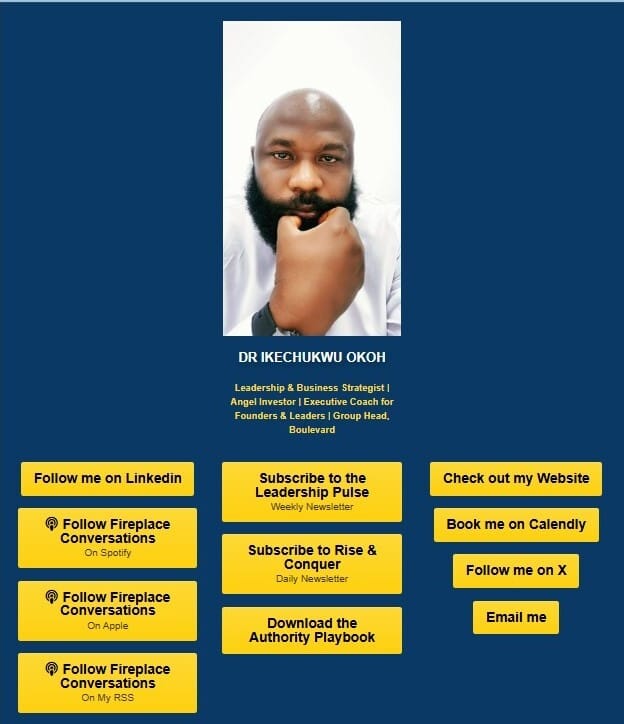- Leadership Pulse
- Posts
- Strategic Alignment Is Your Advantage, Not Speed
Strategic Alignment Is Your Advantage, Not Speed

Welcome To The Leadership Pulse
Welcome to practical insights at the crossroads of leadership, strategy, and growth.
Every week, Dr Ikechukwu Okoh presents MBA-level frameworks, real-world stories, and timeless lessons to help you lead clearly, inspire purposefully, and execute effectively.
Let’s develop leaders who shape the future.
The Day the Team Stopped Moving
I recall being invited to assist a mid-sized organisation that claimed they had a “speed problem.”
“Dr. Ike,” the CEO said during our first call, “our execution is too slow. People drag their feet. Projects stall. Meetings go in circles. We need more urgency.”
I’ve learned to listen carefully when a leader describes a challenge as a “people problem.”
It’s rarely about people.
During the online sessions, I observed how the leadership team interacted with each other.
What struck me wasn’t laziness, incompetence, or lack of motivation.
It was misalignment.
Everyone was pulling hard, just not in the same direction.
The strategy said one thing.
The processes reinforced each other.
The culture rewarded something entirely different.
At one point, I wrote on the whiteboard:
“You don’t have a speed problem.
You have an alignment problem.”
The room went quiet.
This is where the Burke–Litwin Model entered the discussion.
THE LEADERSHIP LESSON: The Burke–Litwin Truth
MBA programs love the Burke–Litwin Model because it explains one timeless leadership reality:
Organizational performance is never the result of one thing. It is the interaction of 12 factors working either with you or against you.

If just one of these 12 elements breaks down, performance slows.
If several misalignments occur, the entire organisation grinds to a halt.
The organisation I worked with wasn’t broken; it was simply operating with conflicting signals across these four layers:
1. External Environment
They were reacting to market changes instead of anticipating them.
2. Transformational Factors
– Leadership direction was unclear
– Mission drift was quietly happening
– Culture rewarded caution, not courage
3. Transactional Factors
– Systems rewarded speed, but processes required endless approvals
– Tasks were assigned, but roles weren’t clarified
– Performance management was inconsistent
4. Individual & Team Factors
– People cared deeply
– But they were confused
– And confusion kills momentum
The leader’s most significant risk is believing performance issues are about “effort.”
They are almost always about alignment.
Find out why 100K+ engineers read The Code twice a week
Staying behind on tech trends can be a career killer.
But let’s face it, no one has hours to spare every week trying to stay updated.
That’s why over 100,000 engineers at companies like Google, Meta, and Apple read The Code twice a week.
Here’s why it works:
No fluff, just signal – Learn the most important tech news delivered in just two short emails.
Supercharge your skills – Get access to top research papers and resources that give you an edge in the industry.
See the future first – Discover what’s next before it hits the mainstream, so you can lead, not follow.
 |  |


Ikechukwu’s Journal
 | Impact doesn’t come from louder competition. It comes from creating new value where none existed before. That’s the quiet power of leadership. You make people see the world differently. |
If you enjoyed this week’s Leadership Pulse, all previous editions are available on Beehiiv, along with bonus insights, frameworks, and templates that you can apply immediately.
As you lead this week, remember:
You don’t always have to win the fight.
Sometimes, you can change the arena.
That’s how transformation begins, not in the noise of rivalry, but in the calm of clarity.
“Subscribe to the Leadership Pulse Newsletter. It is amazing.”- Tolu Ekwe.
Please stay connected with me:
Ikechukwu Okoh
Author of the Leadership Pulse
This week, paid subscribers get
THE MBA FRAMEWORK (SIMPLIFIED): The Burke–Litwin Model in 5 Minutes
THE RULERSHIP RESET: A four-step weekly alignment ritual I give every executive team
THE 12-Question Burke–Litwin Alignment Audit

Subscribe to the Pulse Premium to read the rest.
For leaders who want more than inspiration.
Already a paying subscriber? Sign In.
Unlock Exclusive Access to:
- • Tools & templates to lead with clarity
- • Monthly behind-the-scenes audio reflections
- • Live member-only Q&As and growth calls
- • First access to books, coaching offers, and training
- • Strategy deep dives & private case studies


Reply